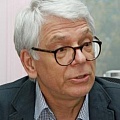As of 01.11.2022
Many new category structures have been discovered by physicists over the last several years. It is obvious that the language of higher categories suits perfectly for describing the cornerstone concepts in the modern theoretical physics. All of this has lead to the separation of many domains of mathematics into categories. The starting point of the Laboratory's research is homological mirror symmetry. Homological mirror symmetry currently serves as the basis for a wide range of absolutely new studies in mathematics that is promoted and constantly updated by many researchers. One of the main flaws of the rich but very technically complex method of homological mirror symmetry is a lack of applications. Focusing namely on applications, the Laboratory researchers are planning to develop the missing link — geometrisation of the category theory based on the interaction with mathematical physics.
Name of the project: Mirror symmetry and automorphic forms
Research directions: Mathematics, mirror symmetry and automorphic forms
Project objective: Uniting efforts of specialists from various domains such as geometry, topology, automorphic form theory and Lie algebras, number theory, mathematical physics for solving the main theoretical problems of mathematics and physics related to mirror symmetry. Study of category, geometry and automorphy, geometric and arithmetic aspects of homological mirror symmetry.
Finding principally new applications of category and Kähler geometry to problems of geometry, to geometric problems of rationality, in automorphic form theory and Lorentzian Kac-Moody algebras.
Geometrization of category theory, and its starting point is the theory of homological mirror symmetry formulated by Maxim Kontsevich.
|
Hosting organization
|
Field of studies
|
City
|
Invited researcher
|
Time span of the project
|
|---|---|---|---|---|
|
Analysis, probability, quantum theory, integrable systems, machine learning and their applications
Saint Petersburg State University - (SPbU) |
Maths |
St. Petersburg |
Hedenmalm Haakan Per
Sweden |
2024-2028 |
|
Laboratory «Nonlinear and nonlocal equations and their applications»
Peoples' Friendship University of Russia - (RUDN University) |
Maths |
Moscow |
Kuksin Sergei Borisovich
Russia, France |
2022-2024 |
|
Probabilistic Methods in Analysis
Saint Petersburg State University - (SPbU) |
Maths |
St. Petersburg |
Hedenmalm Haakan Per
Sweden |
2021-2023 |





